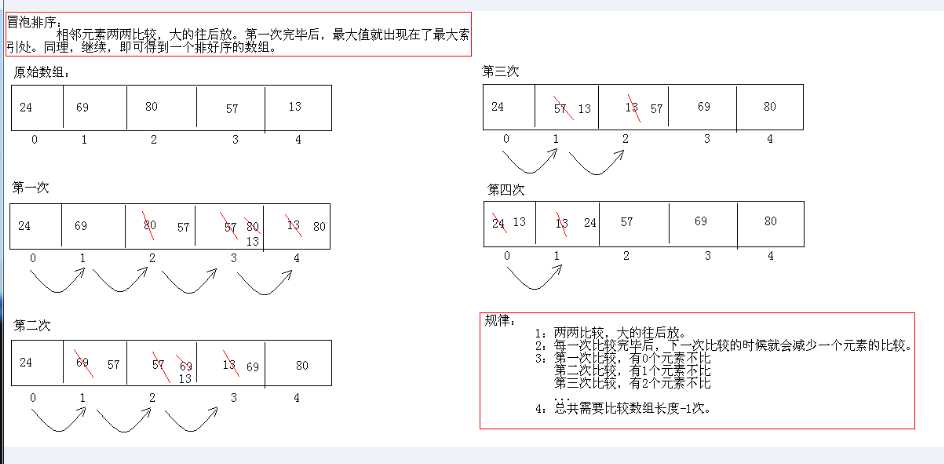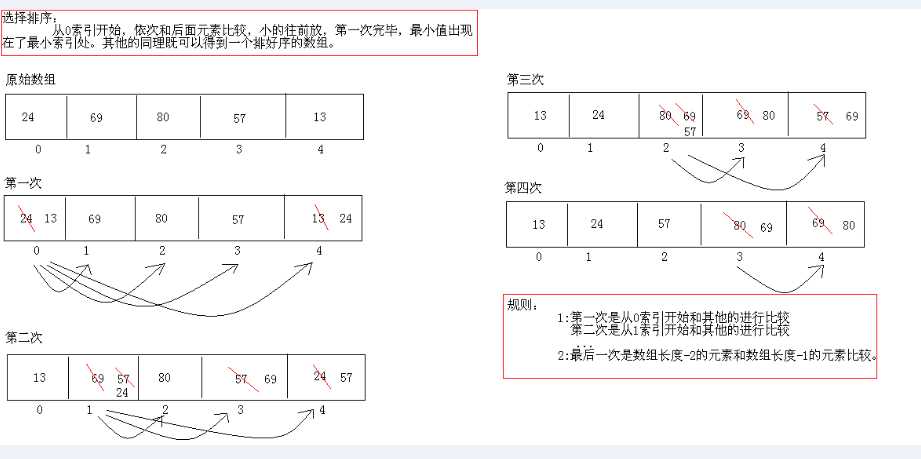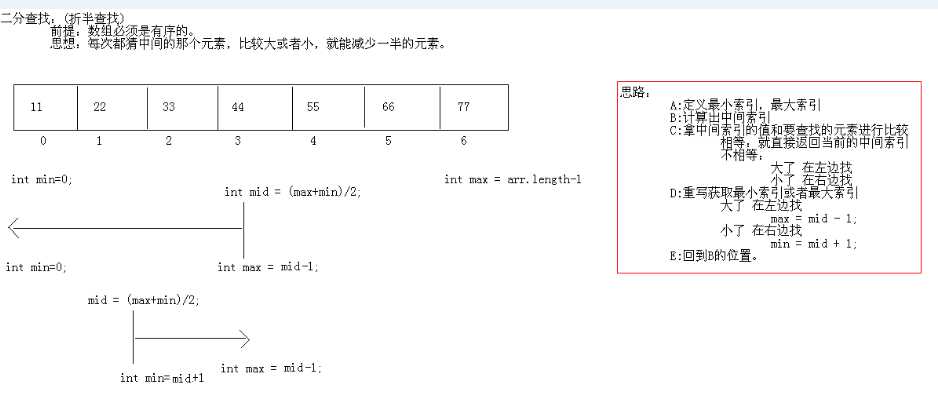标签:代码 sde .so demo 索引 二次 冒泡排序 style 选择排序
冒泡排序
冒泡排序原理

冒泡排序代码:
package cn.itcast_01; /* * 数组排序之冒泡排序: * 相邻元素两两比较,大的往后放,第一次完毕,最大值出现在了最大索引处 */ public class ArrayDemo { public static void main(String[] args) { // 定义一个数组 int[] arr = { 24, 69, 80, 57, 13 }; System.out.println("排序前:"); printArray(arr); bubbleSort(arr); System.out.println("排序后:"); printArray(arr); } //冒泡排序代码 /*总共需要比较数组长度-1次,x < arr.length - 1 *每一次比较完,下一次就会减少一次元素的比较。第一次比较有0个元素不比,第二次有1个元素不比,,,,所以 y < arr.length - 1 - x *两两比较,大的往后放 * */ public static void bubbleSort(int[] arr){ for (int x = 0; x < arr.length - 1; x++) { for (int y = 0; y < arr.length - 1 - x; y++) { if (arr[y] > arr[y + 1]) { int temp = arr[y]; arr[y] = arr[y + 1]; arr[y + 1] = temp; } } } } // 遍历功能 public static void printArray(int[] arr) { System.out.print("["); for (int x = 0; x < arr.length; x++) { if (x == arr.length - 1) { System.out.print(arr[x]); } else { System.out.print(arr[x] + ", "); } } System.out.println("]"); } }
选择排序
选择排序原理图

选择排序代码
package cn.itcast_02; /* * 数组排序之选择排序: * 从0索引开始,依次和后面元素比较,小的往前放,第一次完毕,最小值出现在了最小索引处 */ public class ArrayDemo { public static void main(String[] args) { // 定义一个数组 int[] arr = { 24, 69, 80, 57, 13 }; System.out.println("排序前:"); printArray(arr); //用方法改进 selectSort(arr); System.out.println("排序后:"); printArray(arr); } /* * 数组排序 * */ public static void selectSort(int[] arr){ for(int x=0; x<arr.length-1; x++){ for(int y=x+1; y<arr.length; y++){ if(arr[y] <arr[x]){ int temp = arr[x]; arr[x] = arr[y]; arr[y] = temp; } } } } // 遍历功能 public static void printArray(int[] arr) { System.out.print("["); for (int x = 0; x < arr.length; x++) { if (x == arr.length - 1) { System.out.print(arr[x]); } else { System.out.print(arr[x] + ", "); } } System.out.println("]"); } }
二分查找法
二分查找法原理

二分法的代码实现:
package cn.itcast_04; /* * 查找: * 基本查找:数组元素无序(从头找到尾) * 二分查找(折半查找):数组元素有序 * * 分析: * A:定义最大索引,最小索引 * B:计算出中间索引 * C:拿中间索引的值和要查找的值进行比较 * 相等:就返回当前的中间索引 * 不相等: * 大 左边找 * 小 右边找 * D:重新计算出中间索引 * 大 左边找 * max = mid - 1; * 小 右边找 * min = mid + 1; * E:回到B */ public class ArrayDemo { public static void main(String[] args) { //定义一个数组 int[] arr = {11,22,33,44,55,66,77}; //写功能实现 int index = getIndex(arr, 33); System.out.println("index:"+index); //假如这个元素不存在后有什么现象呢? index = getIndex(arr, 333); System.out.println("index:"+index); } /* * 两个明确: * 返回值类型:int * 参数列表:int[] arr,int value */ public static int getIndex(int[] arr,int value){ //定义最大索引,最小索引 int max = arr.length -1; int min = 0; //计算出中间索引 int mid = (max +min)/2; //拿中间索引的值和要查找的值进行比较 while(arr[mid] != value){ if(arr[mid]>value){ max = mid - 1; }else if(arr[mid]<value){ min = mid + 1; } //加入判断 if(min > max){ return -1; } mid = (max +min)/2; } return mid; } }
Arrays类
package cn.itcast_05; import java.util.Arrays; /* * Arrays:针对数组进行操作的工具类。比如说排序和查找。 * 1:public static String toString(int[] a) 把数组转成字符串 * 2:public static void sort(int[] a) 对数组进行排序 * 3:public static int binarySearch(int[] a,int key) 二分查找 */ public class ArraysDemo { public static void main(String[] args) { // 定义一个数组 int[] arr = { 24, 69, 80, 57, 13 }; // public static String toString(int[] a) 把数组转成字符串 System.out.println("排序前:" + Arrays.toString(arr)); // public static void sort(int[] a) 对数组进行排序 Arrays.sort(arr); System.out.println("排序后:" + Arrays.toString(arr)); // [13, 24, 57, 69, 80] // public static int binarySearch(int[] a,int key) 二分查找 System.out.println("binarySearch:" + Arrays.binarySearch(arr, 57)); System.out.println("binarySearch:" + Arrays.binarySearch(arr, 577)); } }
标签:代码 sde .so demo 索引 二次 冒泡排序 style 选择排序
原文地址:http://www.cnblogs.com/baiyangyuanzi/p/6860453.html